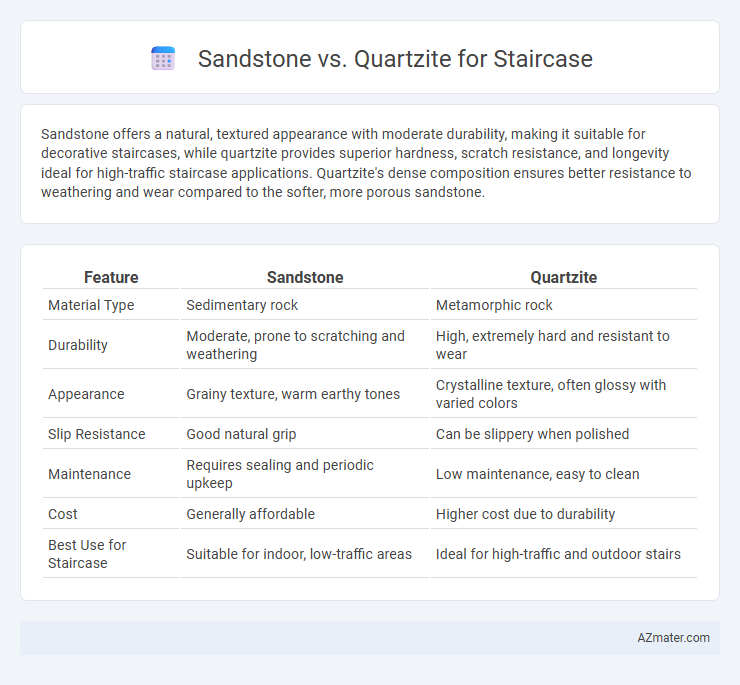Sandstone offers a natural, textured appearance with moderate durability, making it suitable for decorative staircases, while quartzite provides superior hardness, scratch resistance, and longevity ideal for high-traffic staircase applications. Quartzite's dense composition ensures better resistance to weathering and wear compared to the softer, more porous sandstone.
Table of Comparison
| Feature | Sandstone | Quartzite |
|---|---|---|
| Material Type | Sedimentary rock | Metamorphic rock |
| Durability | Moderate, prone to scratching and weathering | High, extremely hard and resistant to wear |
| Appearance | Grainy texture, warm earthy tones | Crystalline texture, often glossy with varied colors |
| Slip Resistance | Good natural grip | Can be slippery when polished |
| Maintenance | Requires sealing and periodic upkeep | Low maintenance, easy to clean |
| Cost | Generally affordable | Higher cost due to durability |
| Best Use for Staircase | Suitable for indoor, low-traffic areas | Ideal for high-traffic and outdoor stairs |
Introduction to Sandstone and Quartzite Staircases
Sandstone staircases showcase natural, earthy tones with a porous texture that offers slip resistance, making them ideal for outdoor and rustic designs. Quartzite staircases provide exceptional durability and a smooth, glassy finish derived from metamorphosed sandstone, suitable for high-traffic and modern environments. Choosing between sandstone and quartzite depends on the desired aesthetic, maintenance requirements, and weather resistance for the staircase installation.
Physical Properties: Sandstone vs Quartzite
Sandstone, composed primarily of sand-sized mineral particles, offers moderate hardness and a porous texture, making it more susceptible to wear and weathering compared to quartzite. Quartzite is a metamorphic rock formed from sandstone subjected to high heat and pressure, resulting in exceptional hardness and density that enhances its durability and resistance to abrasion for staircases. The higher Mohs hardness rating of quartzite (7) compared to sandstone (6 or less) ensures superior structural integrity and longevity in high-traffic areas like stairs.
Durability and Strength Comparison
Quartzite exhibits superior durability and strength compared to sandstone, making it a preferred choice for staircases subjected to heavy foot traffic. Its high quartz content provides exceptional resistance to abrasion, chipping, and weathering, whereas sandstone's softer composition makes it more prone to scratches and erosion over time. For long-lasting staircases, quartzite offers enhanced structural integrity and minimal maintenance requirements compared to the more porous and less durable sandstone.
Slip Resistance and Safety Factors
Sandstone offers moderate slip resistance due to its natural texture, making it safer for staircases in dry conditions, but it can become slippery when wet. Quartzite is highly durable with a rougher surface that provides superior slip resistance, enhancing safety on stairs, especially in high-traffic or outdoor areas. Choosing quartzite for staircases ensures better long-term safety and minimizes slip hazards compared to sandstone.
Aesthetic Appeal and Color Options
Sandstone offers a warm, earthy aesthetic with natural grain patterns that create a rustic and inviting staircase appearance, available in shades of beige, tan, red, and brown. Quartzite presents a more polished and sophisticated look, featuring a glassy texture with vivid, often white, gray, or blue hues that enhance modern and elegant staircase designs. Both materials provide durable options, but sandstone's softer, matte finish contrasts with quartzite's harder, glossy surface, affecting the overall feel and visual impact of the staircase.
Maintenance Requirements and Cleaning Tips
Sandstone staircases require regular sealing to protect against moisture absorption and staining, as the porous nature of sandstone makes it more vulnerable to dirt buildup and weathering. Quartzite is denser and more resistant to scratches and stains, reducing the frequency of maintenance while only needing periodic cleaning with mild detergents and non-abrasive tools. For both materials, avoid acidic or harsh chemical cleaners to maintain surface integrity and enhance longevity.
Cost Differences and Budget Considerations
Sandstone offers a more affordable option for staircases, with costs generally ranging from $5 to $15 per square foot, making it suitable for budget-conscious projects. Quartzite, while more expensive at $15 to $30 per square foot, provides superior durability and resistance to wear, ideal for high-traffic areas. Budget considerations should weigh long-term maintenance expenses of sandstone against the initial higher investment in quartzite's longevity and aesthetic appeal.
Installation Process and Complexity
Installing sandstone staircases typically involves moderate complexity due to its softer texture, allowing easier cutting and shaping with standard masonry tools. Quartzite, being significantly harder and denser, requires specialized equipment such as diamond blades and professional expertise to ensure precise cuts and safe installation, making the process more labor-intensive and time-consuming. The higher durability of quartzite justifies the increased installation complexity for long-term structural integrity and resistance to wear.
Best Applications: Indoor vs Outdoor Staircases
Sandstone offers excellent slip resistance and natural texture, making it ideal for outdoor staircases exposed to weather elements, while quartzite's superior hardness and durability suit indoor staircases requiring elegant aesthetics and resistance to wear. Quartzite's low porosity reduces staining and maintenance, perfect for high-traffic indoor areas, whereas sandstone's more porous nature necessitates sealing for moisture protection outdoors. Choosing sandstone for outdoor use leverages its weathered appearance and grip, whereas quartzite enhances indoor staircases' longevity and refined finishes.
Environmental Impact and Sustainability
Sandstone staircases have a lower environmental impact due to their abundant natural availability and minimal processing requirements, reducing energy consumption and carbon emissions. Quartzite, while more durable and resistant to wear, often involves more energy-intensive quarrying and processing techniques, which can increase its overall environmental footprint. Choosing sandstone supports sustainability through reduced resource extraction and lower embodied energy, whereas quartzite's longevity may offset its initial environmental costs over a longer lifespan.

Infographic: Sandstone vs Quartzite for Staircase
 azmater.com
azmater.com